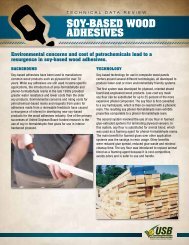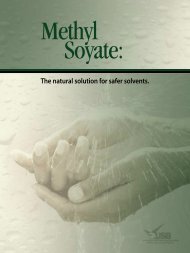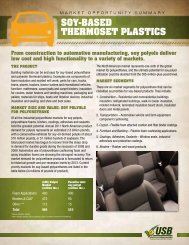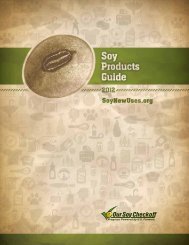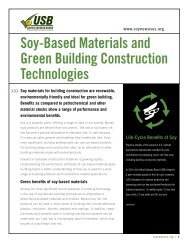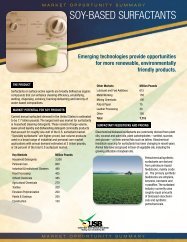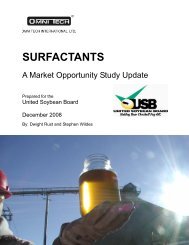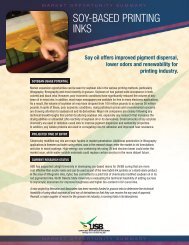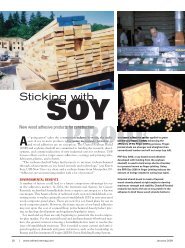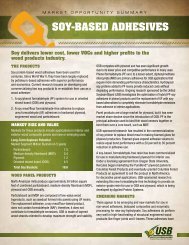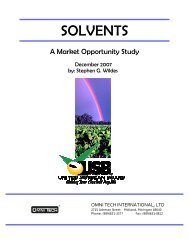SOY CHEMICALS FOR PAPER PROCESSING - Soy New Uses
SOY CHEMICALS FOR PAPER PROCESSING - Soy New Uses
SOY CHEMICALS FOR PAPER PROCESSING - Soy New Uses
You also want an ePaper? Increase the reach of your titles
YUMPU automatically turns print PDFs into web optimized ePapers that Google loves.
aluminum compounds, such as aluminum sulphate (alum), have a coagulating and a chargeneutralizing action. The three main types are:• Single Component - Medium to high molecular weight polyacrylamide, alum or PAC maybe the single component.• Dual Component - A cationic and an anionic component are added separately. Thecationic component can be starch, synthetic polymer or guar gum and the anioniccomponent can be an anionic polymer or a microparticle. The most common syntheticpolymers are those based on polyacrylamide. Polyvinyl amines, polyethylene-imines,polyamides-amines, polyamines, polyethylene-oxide and sulfonated compounds areutilized to a much smaller extent.• Multi-Component - Polyaluminium chloride (PAC), polyDADMAC or a cationic resin isadded to neutralize anionic substances which can interfere with the retention. Enzymesystems based on cellulase or hemicellulase are also used.Dry Strength ResinsDry strength resins increase the internal bond strength and tensile strength of paper byincreasing bonding sites on fibers or by providing stronger bonds. These include:• Cationic starch - has a greater affinity, being positively charged to negatively chargedfibers under standard papermaking conditions. Typical additions in the wet-end of 0.5 -1.5%.• Amphoteric starches - are frequently used in multi-component furnishes and areeffective over a higher pH range. Starch also is used to improve drainage and retention.• Synthetic aids - like low molecular weight polyacrylamides increase the strength of thefiber-fiber bond when added at 0.2 - 0.5% dry basis on fiber. These can be cationic oranionic in nature.• CMC - carboxymethyl cellulose can be used alone or in conjunction with another drystrength aid. CMC increases the negative sites on the fiber which makes it morereceptive to cationic starch in later additions. CMC is added in the pulp at levels that are0.3 - 0.5% per dry basis on fiber.Surface TreatmentsSizing agents are used to fill surface voids to optimize the penetration of ink. Surface sizes areapplied during the dryer stage. In contrast to internal starch, surface starch, that is applied atthe size press, is cheaper (corn-based) but requires more (5%) to reduce viscosity which allowsfor greater surface coverage. Ethoxylated or oxidized starches and blends of starches with non-20



